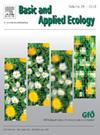Molecular dietary analysis reveals plasticity in habitat requirements of a clutter specialist bat
IF 3.5
2区 环境科学与生态学
Q2 ECOLOGY
引用次数: 0
Abstract
In recent decades, there has been significant progress in studying the foraging habitats of bats. However, these studies provide only a limited understanding of their requirements. Metabarcoding allows species-level identification of consumed prey, allowing us to determine their source habitats. In this study, we sampled faeces from three Rhinolophus hipposideros colonies in different climatic zones from spring to late August. Using metabarcoding, we examined how the lesser horseshoe bat diet changes over time and whether their most-consumed prey varies seasonally across landscapes. Our results show that bat diets change seasonally and differ between colonies, often presumably in response to new prey outbreaks. We deduced from the prey eaten by bats that they have varied habitat requirements. While woodland and shrubs are primary prey source habitats, bats also rely on other environments. We inferred that, in particular, open habitats are exploited more frequently than expected, indicating a high degree of plasticity in their trophic habitat needs. Therefore, protecting diverse, interconnected landscapes with varied prey is crucial for their conservation.
分子膳食分析揭示了杂乱专业蝙蝠对栖息地要求的可塑性
近几十年来,对蝙蝠觅食栖息地的研究取得了重大进展。然而,这些研究只提供了对其需求的有限理解。元条形码可以在物种水平上识别被捕食的猎物,使我们能够确定它们的来源栖息地。在这项研究中,我们从春季到8月下旬在不同气候带采集了三个河马群的粪便样本。使用元条形码,我们研究了小马蹄蝠的饮食如何随时间变化,以及它们最常消耗的猎物是否随季节而变化。我们的研究结果表明,蝙蝠的饮食会随季节而变化,在不同的种群之间也会有所不同,这通常可能是为了应对新的猎物爆发。我们从蝙蝠所吃的猎物推断出它们对栖息地的要求各不相同。虽然林地和灌木是主要的猎物栖息地,但蝙蝠也依赖于其他环境。我们推断,特别是,开放栖息地被开发的频率比预期的要高,这表明它们的营养栖息地需求具有高度的可塑性。因此,保护具有各种猎物的多样化、相互联系的景观对它们的保护至关重要。
本文章由计算机程序翻译,如有差异,请以英文原文为准。
求助全文
约1分钟内获得全文
求助全文
来源期刊

Basic and Applied Ecology
环境科学-生态学
CiteScore
6.90
自引率
5.30%
发文量
103
审稿时长
10.6 weeks
期刊介绍:
Basic and Applied Ecology provides a forum in which significant advances and ideas can be rapidly communicated to a wide audience. Basic and Applied Ecology publishes original contributions, perspectives and reviews from all areas of basic and applied ecology. Ecologists from all countries are invited to publish ecological research of international interest in its pages. There is no bias with regard to taxon or geographical area.
 求助内容:
求助内容: 应助结果提醒方式:
应助结果提醒方式:


